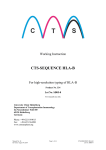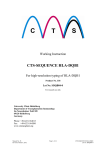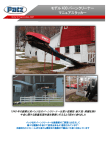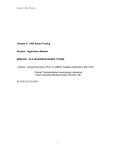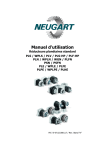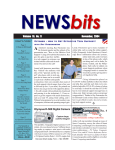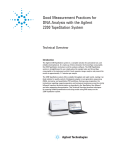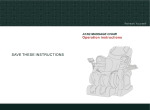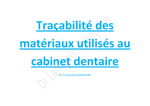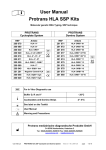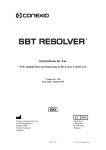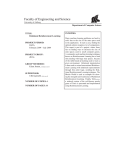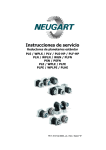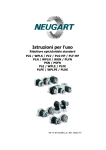Download SDRB04-0
Transcript
Working Instruction CTS-SEQUENCE HLA-DRB1 For high-resolution typing of HLA-DRB1 Product No. 237 Lot No. SDRB04-0 For research use only University Clinic Heidelberg Department of Transplantation Immunology Im Neuenheimer Feld 305 69120 Heidelberg Germany Phone: +49-6221-564013 Fax: +49-6221-564200 www.ctstransplant.org Manual No.37 Revision: April 03, 2012 Page 1 of 16 CTS-SEQUENCE HLA-DRB1 Lot No. SDRB04-0 Content 1 Introduction ...................................................................................................................................................... 3 Materials and Equipment ................................................................................................................................ 3 Materials included in the CTS-SEQUENCE HLA-DRB1 Kit ..................................................................... 3 2.1 Storage and expiration ............................................................................................................................... 4 2.2 Materials and equipment not included ....................................................................................................... 5 2.3 3 Preparation of buffers and agarose gel .......................................................................................................... 6 2 4 Isolation and concentration measurement of DNA ....................................................................................... 7 5 Test procedure .................................................................................................................................................. 7 Amplification .............................................................................................................................................. 7 5.1 Gel control ................................................................................................................................................. 8 5.2 Purification of the amplification products ................................................................................................. 8 5.3 Sequencing reaction ................................................................................................................................... 9 5.4 Purification of the sequencing products ................................................................................................... 10 5.5 Sample preparation for sequencing runs ................................................................................................. 10 5.6 6 Start of a sequencing run on the sequencer ................................................................................................. 10 Instrument protocol for ABI Prism 3100 Genetic Analyzer ..................................................................... 10 6.1 Run Sequencing ........................................................................................................................................ 11 6.2 7 Result evaluation ............................................................................................................................................ 11 8 Troubleshooting ............................................................................................................................................. 13 Amplification ............................................................................................................................................ 13 8.1 Sequencing ............................................................................................................................................... 13 8.2 Appendix Worksheet Amplification Protocol………………………………………………………........ Worksheet Pipetting Scheme………………………………………………………………….. Manual No.37 Revision: April 03, 2012 Page 2 of 16 15 16 CTS-SEQUENCE HLA-DRB1 Lot No. SDRB04-0 The CTS-SEQUENCE HLA-B Kit is delivered at room temperature. Immediately upon receipt, store PCR Buffer & sequencing primers at -20°C and PCR minitrays at 4°C. 1 Introduction This working instruction describes the procedure for high-resolution genotyping of the human leukocyte antigens HLA-DRB1 with the CTS-SEQUENCE HLA-DRB1 Kit. PCR-sequencing based typing (PCR-SBT) is an accurate and reliable method, allowing high resolution of HLA alleles at least 4-digit level. The strategy is based on two consecutive steps: first, group-specific amplification of exon 2 of HLA-DRB1; second, the amplification products are sequenced in forward and reverse direction. Matching for exon 2 (antigenrecognition site) at allele-level is considered relevant in hematopoietic stem cell transplantation. The SEQUENCE HLA-DRB Kit is validated and optimized with following reagents, instruments, softwares and methods: - GeneAmp® PCR System 2700 Thermocycler (Applied Biosystems, Darmstadt, Germany). Amplification with the MBI Taq polymerase (Fermentas, St. Leon-Rot, Germany). Purification of amplification products with EXO-SAP-IT (USB, Staufen, Germany). Sequencing reaction with BigDye terminator v1.1 Kits (Applied Biosystems, Darmstadt, Germany). Purification of the sequencing products using ethanol precipitation. Resuspension of sequencing products with HiDi formamide (Applied Biosystems, Darmstadt, Germany). Separation of sequencing products with the ABI PRISM 3100 Genetic Analyzer (Applied Biosystems, Darmstadt, Germany). Sequence analysis and HLA allele assignment with Sequence PilotTM-HLA SBT (JSI Medical Systems, Kippenheim, Germany). Other reagents, instruments etc. may be used, but should be validated by the user. The CTS-SEQUENCE kits have been validated to be performed with the GeneAmp® PCR System 2700 thermocycler. If other cyclers are used, the ramp rate has to be set at 1°C/sec. According to EFI standards for histocompatibility testing (Version 5.6.1; L3.2520) PCR-SBT typing of HLA-class II bases on amplification and sequencing primers which are located outside of exon 2. For many HLA-class II variants only the sequence of the antigen recognition site (exon 2 ) are reported. Even though the PCR-SBT HLASEQUENCING Kits have been extensively tested and validated, an allelic drop out of a rare or new allele due to mutations in the priming sites cannot be categorically ruled out. 2 2.1 Materials and Equipment Materials included in the CTS-SEQUENCE HLA-DRB1 Kit The SEQUENCE HLA-DRB1 Kit provides reagents sufficient for twenty four HLA-DRB1 high resolution typings and contains: 1) 2) 3) Twenty-four 16-well PCR minitrays. 12 wells contain dried primer mixes, each tray for one HLA-DRB1 typing. Store at 4°C in pre-PCR area. 3 tubes of CTS-SEQUENCE PCR Buffer (1400 µl). Store at -20°C in pre-PCR area. Sequencing primers (500 µl each): DRB-E2F, DRB-E2R Store at -20°C in post-PCR area. Manual No.37 Revision: April 03, 2012 Page 3 of 16 CTS-SEQUENCE HLA-DRB1 Lot No. SDRB04-0 a) PCR stripes and amplification mixes: The amplification primers are prepipetted and dried in purple PCR stripes (Note: only 12 of the 16 cavities contain primers). For quality reasons, we recommend to use only the caps included in the package. Figure 1 shows the positions of the PCR mixes on the stripe and the allele group(s) and the exons amplified by these mixes. Amplified Allels Mix 08 X 07 X 06 X 05 X DRB12 *07, 09, 10 DRB11 *01, 03, 04, 08, 11, 12, 13, 14, 15, 16 DRB10 *13:01/02, 13:16, 13:18, 14:17, 14:21 DRB09 *10 DRB08 *15, 16 DRB07 *08,12 DRB06 04 12 03 11 02 10 01 09 *11, 13, 14 (except *14:03, 14:06, 13:15, 14:20) DRB05 *09 DRB04 *07 DRB03 *04 DRB02 *03, 14:03, 14:06, 13:15, 14:20 DRB01 *01 Black marker line Figure 1: Mix position on CTS-SEQUENCE HLA-DRB1 tray. The X marked wells contain no primer mixes. b) Sequencing primers: The tubes containing the sequencing primers (500 µl) have purple colored caps. Mix DRB11 can only be sequenced in reverse direction (DRB-E2R) and mix DRB12 can only be sequenced in forward direction (DRBE2F). Table 1: Labeling of the sequencing primers HLA-Locus Tube label HLA-DRB1 DRB-E2F DRB-E2R 2.2 Sequenced Exon 2 2 Not Applicable for Mix DRB11 DRB12 Direction of sequencing forward reverse Storage and expiration All kit components are labeled with storage condition and date of expiration. Frequent thawing and freezing can reduce the quality of the reagents and should be avoided. It is recommended to make aliquots of appropriate volumes and store them as indicated. Manual No.37 Revision: April 03, 2012 Page 4 of 16 CTS-SEQUENCE HLA-DRB1 Lot No. SDRB04-0 2.3 Materials and equipment not included Table 2: Pre-PCR area Reagents/materials/softwares Taq DNA Polymerase (5 U/µl) Ultra Pure Agarose Ethidium bromide (10 mg/ml) Cave: potentially carcinogenic! Magnetic stirring hotplate or a microwave oven for gel preperation Pipettes and filter tips for 0.5-10 µl, 10- 200 µl and 200-1000 µl volumes Sequence PilotTM-HLA SBT Photometer for spectral measurememnt of DNA concentration 50x TAE buffer Company/Catalogue number Fermentas, St. Leon-Rot, Germany Cat.No EP0401/ EP0402 Inno-Train, Kronberg/Taunus, Germany Cat. No. GX04090 Sigma-Aldrich GmbH, Steinheim, Germany Cat.No. E1510-10ML Eppendorf, Wessing-Berzdorf, Germany JSI Medical Systems GmbH, Kippenheim, Germany Inno-Train, Kronberg/Taunus, Germany Cat.No. GX12765 Analytical balance Manual No.37 Revision: April 03, 2012 Page 5 of 16 CTS-SEQUENCE HLA-DRB1 Lot No. SDRB04-0 Table 3: Post-PCR area ExoSAP-ITTM Reagents/materials/softwares BigDyeTM Terminator Cycle Sequencing Kit v1.1 (Sequencing buffer (5x) included) 1x TAE electrophoresis buffer HiDi Formamide Loading buffer (bromophenol blue) Sodium-Acetat 3M pH 5.2 for precipitation Ethanol absolute GR for analysis Ethanol 70% 10x EDTA running buffer for the sequencer 1x EDTA running buffer for the sequencer Centrifuge for PCR plates GeneAmp® PCR System 2700 thermocycler Power supplier for electrophoresis Gel Documentation System Gel elektophoresis chamber Capillary sequencer: ABI PRISM 3100 Genetic Analyzer 8-channel pipette and filter tips 0.5-10 µl Pipettes and filter tips for 0.5-10 µl volume Multipette and combitips (0.1, 0.2 ,0.5, 1.0, 2.5ml) Not mandatory Adhesive aluminium foils for 96-well PCR plate Optical 96-well reaction plate and optical caps Company/Catalogue number USB, Staufen, Germany Cat.No. 78202 Applied Biosystems, Darmstadt, Germany Cat.No.4336791 See section 3 below for instruction Applied Biosystems, Darmstadt, Germany Cat.No. 4311320 Fermentas, St. Leon-Rot, Germany Sigma Aldrich, Germany Cat.No. S7899 Merck, Darmstadt, Germany Cat.No. 1.00983.1000 See section 3 below for instruction Applied Biosystems, Darmstadt, Germany Cat.No. 402824 Applied Biosystems, Darmstadt, Germany Applied Biosystems, Darmstadt, Germany Eppendorf, Wessing-Berzdorf, Germany Cat.No. 0030.077.040 Eppendorf, Wessing-Berzdorf, Germany Cat.No. 0030.077.040 Eppendorf, Wessing-Berzdorf, Germany Kisker, Steinfurt, Germany Cat.No. GO71 Applied Biosystems, Darmstadt, Germany Cat.No. N801-0560, N801-0535 Table 4: Pre-PCR and post-PCR area (two sets are needed!) Reagents/materials/softwares HPLC water (LiChrosolv® water) Company/Catalogue number Merck, Darmstadt, Germany Cat.No. 1.15333.1000 Vortexer Reaction tubes 1.5 ml Eppendorf, Wessing-Berzdorf, Germany Cat.No. 0030 120.086 Examination gloves Nitril gloves 3 Preparation of buffers and agarose gel 1x TAE electrophoresis buffer: 49 volume parts of deionised water + 1 volume part of 50x TAE electrophoresis buffer Ethanol 70%: 7 volume parts of absolute ethanol + 3 volume parts of HPLC water 2% agarose gel: If you use CTS electrophoresis chamber and CTS combs (see www.ctstransplant.org for order information) proceed as follows: Manual No.37 Revision: April 03, 2012 Page 6 of 16 CTS-SEQUENCE HLA-DRB1 Lot No. SDRB04-0 - 4 Add 7 g of agarose and 7 ml of 50x TAE buffer to 350 ml of ddH 2 0. Boil to dissolve the agarose, using a magnetic stirring hot plate or a microwave oven. Cool down to 60 °C, add 17 µl of ethidium bromide (10 mg/ml), mix and pour the gel. Allow the gel to set for 1 hour at room temperature. Cave: Ethidium bromide is potentially carcinogenic! Wear appropriate protection, e.g. nitril gloves. On a 20x25 cm gel, you can place up to six CTS combs. These combs have a tooth distance corresponding to that of the channels of a standard 8-channel pipette. This allows the use of such a pipette for rapid loading of the samples onto the gel. Isolation and concentration measurement of DNA Genomic DNA can be isolated from all nucleated cells. Starting material can be EDTA or citrate blood, buffy coats, cell suspensions etc. Heparinized blood should not be used. DNA can be isolated by the salting out method (Miller SA et al., Nucleic Acid Research 1999) or magnetic particle technology (e.g. GenoM-6/Qiagen EZ1 robot, Qiagen, Vienna, Austria). Magnetic beads should be separated from the DNA (e.g. by centrifugation). It is likely that other commercial kits or automats for DNA isolation will also work, but they should be validated by the users. For optimal reaction, adjust the DNA concentration to approximately 25 ng/µl with HPLC water. Cave: Human material should always considered to be potentially infectious and be handled with care. See your own standard laboratory safety guidelines. 5 Test procedure High resolution HLA-typing with the CTS-SEQUENCE HLA-DRB1 Kit is performed in 7 steps: - Amplification of the HLA locus by PCR (setup in pre-PCR area; thermal cycling in post-PCR area) Electrophoresis to check for positive amplifications (“gel control”) (post-PCR area) Purification of the (positive) amplification products for sequencing (post-PCR area) Sequencing reaction (post-PCR area) Purification of the sequencing products (post-PCR area) Separation of the sequencing products in the capillary sequencer (post-PCR area) Sequence analysis and allele assignment with the Sequence PilotTM-HLA SBT software 5.1 Amplification Prepare PCR on ice. Fill in your PCR protocol. Label your PCR-minitray. Thaw PCR Buffer. Pre-mix 10.85 µl of PCR Buffer with 4 µl of 25 ng/µl genomic DNA and 0.15 µl of Taq polymerase for each mix (each PCR). An excess volume to compensate loss during pipetting is recommended. For example, if you want to perform one CTS-SEQUENCE HLA-DRB1 test (12 mixes), prepare a pre-mix for 14 mixes (151.9 µl of PCR Buffer + 56 µl of 25 ng/µl DNA + 2.1 µl of Taq). Vortex the pre-mix. Pipette 15 µl of the pre-mix into each well of the minitray. 10.85 µl PCR Buffer Close the tubes and spin them down. + 4 µl DNA (25 ng/µl) Put the minitray into the thermocycler and start the ampli+ 0.15 µl Taq Polymerase fication program CTS-AMP (see below). 15 µl reaction volume Cave: DNA resolved in buffers should always be diluted at least 1:1 with HPLC water prior to use in the amplification (buffers often contain PCR inhibitors e.g. EDTA). Manual No.37 Revision: April 03, 2012 Page 7 of 16 CTS-SEQUENCE HLA-DRB1 Lot No. SDRB04-0 Cave: Do not use hot start polymerase (e.g. AmpliTaq Gold, Applied Biosystems) or a proofreading polymerase! Thermocycler program for amplification (CTS-AMP): Step 1 2 3 4 Temperature 95 °C 95 °C 65 °C 95 °C 61 °C 72 °C 4 °C Time 2 min 15 s 2 min 15 s 50 s 1 min 30 s ∞ Numbers of cycles 1 10 22 Cave: Do not forget to enter the reaction volume of 15 µl! 5.2 Gel control The amplification products are separated on a 2% agarose gel by electrophoresis. This step is to check for success of the amplification step and to identify the amplification mix(es) which will be subjected to sequencing. A) Electrophoresis Pre-pipette 5 µl of loading buffer for each amplification product into a PCR plate. Add 5 µl of your amplification product. Use filter tips to avoid contamination. Load the gel with 10 µl of the amplification/loading buffer mixture. If you use CTS electrophoresis chamber, run the electrophoresis for 20 min at 170 Volts (approx. 0.4 V/cm2). Cave: Ethidium bromide is potentially carcinogenic! Wear appropriate protection, e.g. nitril gloves! B) Documentation and interpretation Place the gel on a UV light transilluminator (312 nm) and take a polaroid picture for interpretation and documentation. Wear UV-protection goggles! You can proceed with an amplification product if a band representing the specific amplicon is visible in the gel picture. The length of the specific amplification products range from 610 to 1030 bp. Cave: Do not mistake primer dimers or primer clouds for specific amplification products! Primer dimers are very small (15-50 bp). Use a size marker if you are not confident. 5.3 Purification of the amplification products Before an amplification product is subjected to sequencing, it has to be purified e. g. with ExoSAP-ITTM (USB, Staufen, Germany). ExoSAP-ITTM contains an exonuclease digesting single-stranded DNA (e.g. primers) and a phosphatase inactivating the nucleotides. This enzymatic purification method is simple and appropriate to perform large-scale testing. A further advantage compared with other methods is that the enzymatic digest is performed in the same tube that will subsequently be used for the amplification step. This avoids contaminations and a mix-up of samples. Add 4 µl of ExoSAP-ITTM (2µl ExoSAP-ITTM per 5µl PCR products) to each well with a positive PCR reaction (based on the gel control). For large-scale performances, a Multipette can be used. Close the reaction tubes (avoid contaminations!). Spin down the ExoSAP-ITTM in the reaction tubes. Put the PCR reaction wells into the thermocycler and start the purification program CTS-PUR (see below). Manual No.37 Revision: April 03, 2012 Page 8 of 16 CTS-SEQUENCE HLA-DRB1 Lot No. SDRB04-0 Cave: ExoSAP-ITTM is a viscous fluid, vortex well before use and get rid of excessive enzyme hanging at the tip of your pipette. Thermocycler program for purification with ExoSAP-ITTM (CTS-PUR): Step 1 2 3 Temperature 37 °C 80 °C 4 °C Time 15 min 15 min ∞ Numbers of cycles 1 1 Cave: Do not forget to enter the reaction volume of 14 µl. 5.4 Sequencing reaction General strategy - - For high resolution typing of HLA class II, exon 2 must be completely sequenced. If an allele is not separated by amplification, we recommend to sequence in both directions (forward and reverse) to optimize base-calling Mix DRB11 and DRB12 are especially designed to cover all HLA-DRB1 allele groups in minimum by two amplification mixes (on of the mixes DRB01 to DRB10 plus mix DRB11 or DRB12). This strategy is used to reduce the risk of an allelic drop out due to a failed amplification. In case of homozygous results (single allele), in addition to the one positive mix of the mixes DRB01 to DRB10, mix DRB11 or DRB12 (if positive) should be sequenced with DRB-E2R or DRB-E2F, respectively. If the alleles are separated by amplification (e. i. if two group-specific mixes are positive), it is sufficient to sequence the positive amplicons in only one direction (we recommend to use the reverse primers). Setting-up a sequencing reaction Create a pipetting scheme determining which amplicon(s) and which sequencing primer(s) are pipetted into which position(s) of the optical 96-well reaction plate. An example of a pipetting scheme can be seen in the appendix. Place an optical 96-well reaction plate on ice. Mix one volume of BigDye terminators (BDT) with one volume of 5x BigDye sequencing buffer (always prepare freshly). Keep an excess volume to compensate loss during pipetting. Pipette 2 µl of the mixture into the optical 96-well reaction plate. Alternatively, pipette 1 µl of BigDye terminators + 1 µl of 5x BigDye sequencing buffer directly into the optical 96-well reaction plate. Close the wells with caps and spin down. Add 6 µl of sequencing primer. Add 2 µl of purified amplification product (DNA template). 1 µl BDT Spin down, close the plate with caps and place it into the thermocycler. + 1 µl 5x buffer Start the thermocycler program CTS-SEQ. + 6 µl Primer + 2 µl Template Cave: Keep the BigDye terminators cool and minimize their exposure to light. 10 µl . Thermocycler program for sequencing reaction (CTS-SEQ): Step 1 2 3 Temperature 96 °C 96 °C 60 °C 4 °C Time 1 min 10 s 2 min ∞ Numbers of cycles 1 25 Cave: Do not forget to enter the reaction volume of 10 µl. Proceed with the purification of the sequencing products immediately when the sequencing reaction has finished. Manual No.37 Revision: April 03, 2012 Page 9 of 16 CTS-SEQUENCE HLA-DRB1 Lot No. SDRB04-0 5.5 Purification of the sequencing products Residual ddNTPs must be removed to avoid sequencing artifacts (e.g. dye blobs). This can be done e. g. by ethanol precipitation which is a cheap method and can be used for high-throughput. - Pre-mix 1 µl of 3 M Sodium-Acetate (pH 5.2) with 25 µl of absolute ethanol for each sequencing reaction to be purified. An excess volume to compensate loss during pipetting is recommended. Add 25 µl of the pre-mix to each sequencing reaction. Close the optical 96-well reaction plate with an adhesive aluminium foil and vortex well (30 sec). Vortexing is crucial for a good precipitation! Incubate the optical 96-well reaction plate at room temperature in a dark place for 15 min (keep light exposure of ddNPTs low). Centrifuge the optical 96-well reaction plate for 30 min at 2000 x g. Proceed immediately with the next step. If you can not proceed immediately, centrifuge again for 3min at 2000 x g before the next step. Remove the adhesive aluminium foil, flip the optical 96-well reaction plate and remove the supernatant. Place the optical 96-well reaction plate upside down on paper towel into the centrifuge. Spin the plate for a few seconds at 180 x g to dry. Add 75 µl of 70% ethanol to the precipitated sequencing products and vortex briefly. Centrifuge the optical 96-well reaction plate for 10 min at 2000 x g. Proceed immediately with the next step. If you can not proceed immediately, centrifuge again for 3min at 2000 x g before the next step. Remove the adhesive aluminium foil, flip the optical 96-well reaction plate and remove the supernatant. Place the optical 96-well reaction plate upside down on paper towel into the centrifuge. Spin the plate for a few seconds at 180 x g to dry. Keep the plate in a dark place until all ethanol has evaporated (~ 20 min). In dried form, the sequencing products are quite stable when kept in the dark. 5.6 Sample preparation for sequencing runs - Add 15µl of HiDi Formamide onto the dried sequencing products, close the wells with caps and spin down. Put the plate into a thermocycler and denature for 2 min at 95 °C. IMPORTANT: Vapours at high temperatures. Cool down the HiDi Formamide at 4 °C before opening the caps. 6 Start of a sequencing run on the sequencer 6.1 Instrument protocol for ABI Prism 3100 Genetic Analyzer (Applied Biosystems, Darmstadt, Germany) POP medium Capillary Electrophoreses buffer Instrument Protocol Sequence File Format Ending Base Mixed Base Clear Range Method Manual No.37 Revision: April 03, 2012 3100 POP-6 36 cm array 1x buffer with EDTA Type Regular Run Module CTS2600 Dye Set E-Big-DyeV1 True Profile At PCR Stop Do not assign N’s to Basecalls Use Mixed Base Identification Call IUB if 2nd highest Peak is 25% of the highest peak Use quality values, Remove bases from ends until viewer Page 10 of 16 CTS-SEQUENCE HLA-DRB1 Lot No. SDRB04-0 Mobility file Sequencing Analysis Software Run Module (CTS2600) Basecaller Settings Sample Manager Settings Plate Record 6.2 then 10 bases out of 20 have QVs less then 15 3100_POP6_BDTv1 Vers. 5.1.1 Run Temperature 55 °C Leak Threshold 25 steps Current tolerance 100 uAmps Run current 100 uAmps Voltage tolerance 0.6 kVolts Pre Run Voltage 15 KVolts Pre Run Time 180 sec Injection Voltage 1,2 kVolts Injection Time 10 sec Run Voltage 15 kVolts Number of Steps 10 steps Voltage Step Interval 60 sec Data delay Time 240 sec Run Time 2600 sec KB.bcp Basecaller:KB.bcp Dye set/primer file: KB_3100_POP6_BDTv1.mob Dye Set: E Mobility File: 3100_POP6_BDTv1.mob Run Module: CTS2600 Run Sequencing 1) Transfer your sequencing pipetting scheme into the “Plate Record” of the ABI PRISM 3100 Genetic Analyzer. If the sequences should be later analyzed with the software Sequence PilotTM (JSI Medical Systems GmbH, Kippenheim, Germany) (see section 7), the sample naming conventions are: (Sample name_Amplification mix_Sequencing primer) Example: (Sample_DRB01_DRB-E2F) if amplification mix DRB01 was used in the sequencing reaction with the DRB-E2F sequencing primer. 2) Place samples into the ABI PRISM 3100 Genetic Analyzer and run the instrument. For details, refer to the User Guides of ABI PRISM 3100 Genetic Analyzer and its softwares. 7 Result evaluation For allele assignment, the sequences are loaded into the Sequence PilotTM-HLA SBT Allele Identification Software (JSI Medical Systems GmbH, Kippenheim, Germany). This software shows the electropherograms and aligns them with HLA alleles as listed in the IMGT/HLA Sequence Database (http://www.ebi.ac.uk/imgt/hla/). Mismatches to the proposed HLA alleles, if shown, can be edited. The sequencing results can be printed and archived. For details, see User Manual of the Sequence Pilot TM-HLA SBT Allele Identification Software. Add the sequencing primers with following names and parameters in the “Seq. Primer master file”: Manual No.37 Revision: April 03, 2012 Page 11 of 16 CTS-SEQUENCE HLA-DRB1 Lot No. SDRB04-0 HLA-DRB1 Name Gene Direction SeqPrimer gene parts RFName Sorting DRB-E2F DRB1 fwd. E2 DRB-E2F 0 DRB-E2R DRB1 rev. E2 DRB-E2R 0 Adding the sequencing primer to the “Seq. Primer master file” is not mandatory. However, by doing so, one can avoid a situation in which a forward sequence of exon 3 is shown, which has been sequenced by the forward sequencing primer of exon 2; such a sequence will have bad quality and can be omitted. Manual No.37 Revision: April 03, 2012 Page 12 of 16 CTS-SEQUENCE HLA-DRB1 Lot No. SDRB04-0 8 8.1 Troubleshooting Amplification Observation No, weak or non-specific PCR-product(s). Possible Cause(s) Degraded DNA DNA concentration to low DNA contains PCR inhibitors Thermocycler is defect. → Some primary checks: Did you follow the amplification protocol? Did you vortex the solution well? Was the correct cycler program used? Was ethidium bromide included in the gel? 8.2 Incorrect thermocycler program Thermocycler program needs to be adapted. Taq Polymerase needs to be adapted. Solution New extraction of DNA New extraction of DNA Heparinized blood? New extraction of DNA Check cycler (e.g. with the CTS Cycler Control Kit) Correct programm and repeat PCR Our method was optimized for the GeneAmp® PCR System 2700 Thermocycler. For other thermocyclers, the cycling program may have to be adjusted and validated. Our method was optimized for the Taq DNA Polymerase purchased from Fermentas, St. Leon-Rot, Germany, Cat.No EP0401/ EP0402. Repeat PCR with this polymerase. Sequencing Observation No signal Weak signals Possible Cause(s) No sample was in sequencing reaction. Not enough formamide or air bubble at the bottom of the well. Wrong “injection time” or “injection voltage”. Not enough sequencing products after purification. Not enough sequencing products were loaded. Signals are too strong Wrong “injection time” or “injection voltage”. High concentration of sequencing products. Manual No.37 Revision: April 03, 2012 Page 13 of 16 Solution Repeat sequencing reaction. Pipette enough formamide and spin down well. Differences between capillary sequencer can occur. Adapt “injection time” or “injection voltage” to get fluorescent intensities between 400 and 9000 in raw data. Cleaning-up by ethanol precipitation requires very precise ethanol concentrations. Ethanol concentration can vary when tubes are frequently opened. Aliquot ethanol solutions for single use. Increase “injection time” or “injection voltage”. Salt can reduce the amount of loaded sequencing products. Reduce salt contamination during ethanol precipitation. Differences between capillary sequencer can occur. Adapt “injection time” or “injection voltage” to reach fluorescent intensities between 400 to 9000 in raw data. Reduce the amount of PCR product used in the sequencing reaction. The CTS-SEQUENCE HLA-DRB1 Lot No. SDRB04-0 Electropherogram has high background. DyeBlobs Very high, randomly occurring peaks (spikes) Two different peaks run at nearly the same position in the electropherogram Manual No.37 Revision: April 03, 2012 Purification of PCR amplification products did not work well (primer contamination). Contamination with a second sequencing primer. Double sequence which starts in the forward and reverse sequencing reaction at the same base (in different directions). Purification of sequencing products did not work well (leftover of dye). Air bubbles or polymer crystals in capillaries. Secondary structures of sequencing products (gel compression) Page 14 of 16 reduced amount should be substituted with HPLC water (e.g. dilute amplicon with HPLC water) Repeat PCR and purification of amplification products. Avoid contamination during pipetting sequencing primers. Double sequence due to inserts or deletions within an HLA-Bllele. Ethanol concentration during precipitation to high. Refill capillaries with new polymer. This phenomenon is sequencedependent and occurs only in one sequencing direction of a limited region. Analyze this region with the sequencing primer for the other direction. The sequences obtained with the forward primers tend to show gel compressions more often than reverse primers. CTS-SEQUENCE HLA-DRB1 Lot No. SDRB04-0 CTS-SEQUENCE HLA-DRB1 Amplification Protocol For Lot DRB04-0 Date: DNA-No.: Thermocycler: Lot Volume PCR Buffer 10,85 µl TAQ 0,15 µl* DNA (25ng/µl) 4 µl *The exact amount of Taq-Polymerase needed may vary depending on brand and lot; it should therefore be established through your own validation. Photo Mix Positive/ purified DRB01 DRB02 DRB03 DRB04 DRB05 DRB06 DRB07 DRB08 DRB09 DRB10 DRB11 DRB12 Length of Amplificat Amplified Alleles Amplified Exon 840 990 760 740 850 886 1030 850 710 730 850 610 *01 *03, 14:03, 14:06, 13:15, 14:20 *04 *07 *09 *11, 13, 14 (except *14:03, 14:06, 13:15, 14:20) *08, 12 *15, 16 *10 *13:01/02, 13:16, 13:18, 14:17, 14:21 *01, 03, 04, 08, 11, 12, 13, 14, 15, 16 *07, 09, 10 2 2 2 2 2 2 2 2 2 2 2 2 Cave: Mix DRB11 can only be sequenced with the sequencing primer DRB-E2R and Mix DRB12 only with DRBE2F. Comment: Date, Signature Operator: Date, Signature Reviewer: Manual No.37 Revision: April 03, 2012 Page 15 of 16 CTS-SEQUENCE HLA-DRB1 Lot No. SDRB04-0 Pipetting scheme (Example) Optical 96-well reaction plate 1 A B C D E 2 3 4 5 6 7 8 9 (Stan_DRB02 _DRB-E2F) (Stan_DRB02 _DRB-E2R) (Stan_DRB05 _DRB-E2F) (Stan_DRB05 _DRB-E2R) (Stan_DRB11 _DRB-E2R) F G H DNA sample ID: Name (e.g. Stan) Amplification pattern of the B-locus: X DRB05 positive X X Position on plate A1 A2 A3 A4 A5 Mix DRB02 was sequenced with the DRB-E2F sequencing primer Mix DRB02 was sequenced with the DRB-E2R sequencing primer Mix DRB05 was sequenced with the DRB-E2F sequencing primer Mix DRB05 was sequenced with the DRB-E2R sequencing primer Mix DRB11 was sequenced with the DRB-E2R sequencing primer DRB11 positive DRB02 positive Manual No.37 Revision: April 03, 2012 Page 16 of 16 CTS-SEQUENCE HLA-DRB1 Lot No. SDRB04-0 10 11 12
















